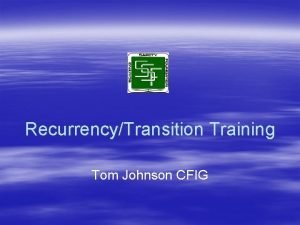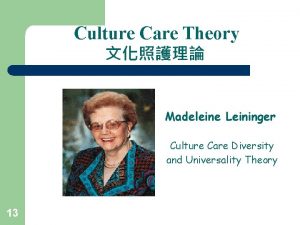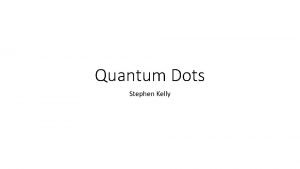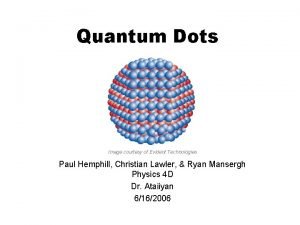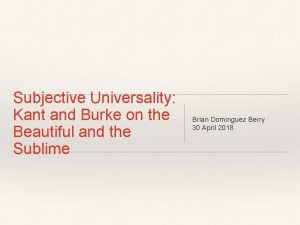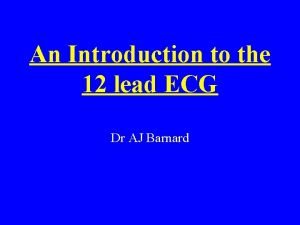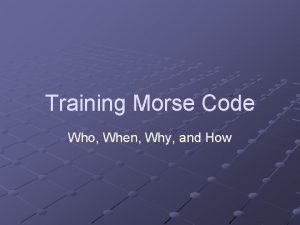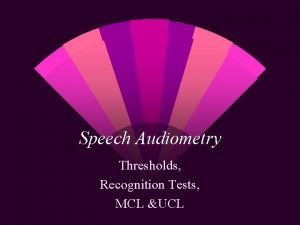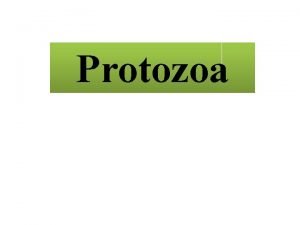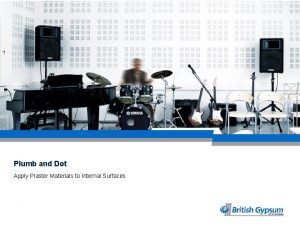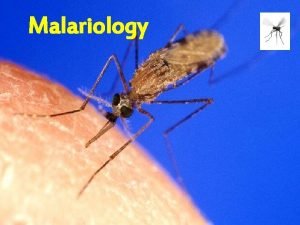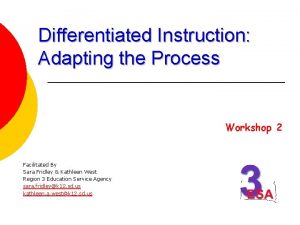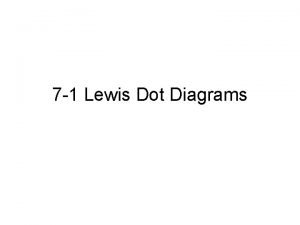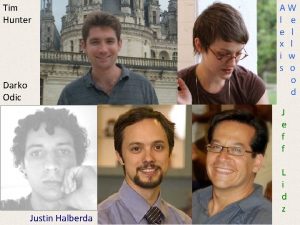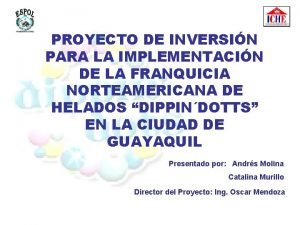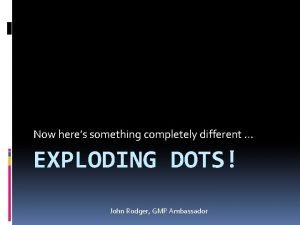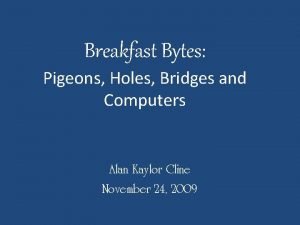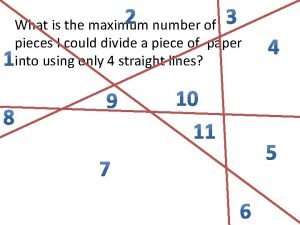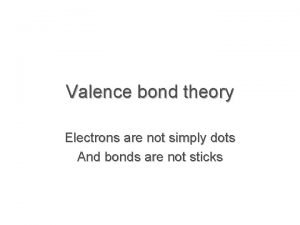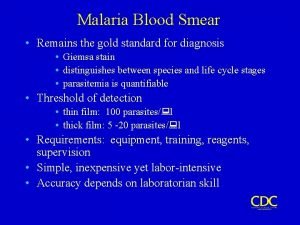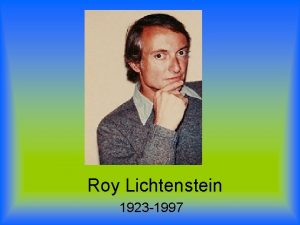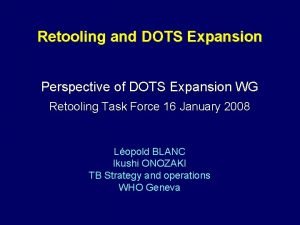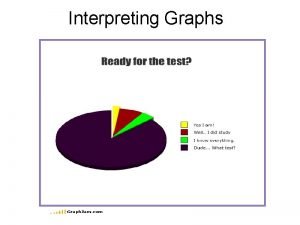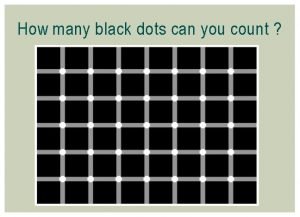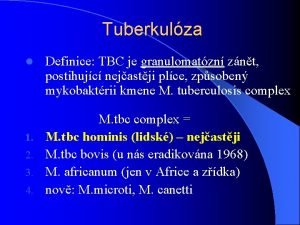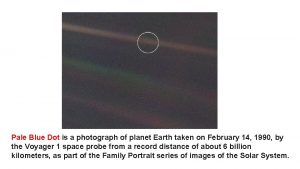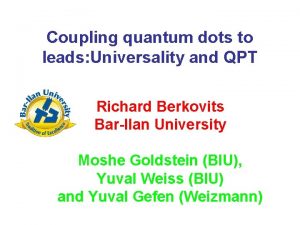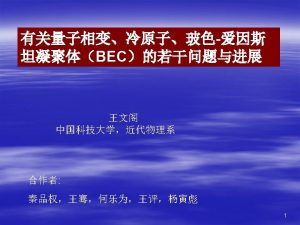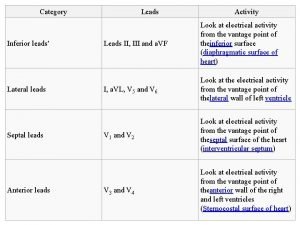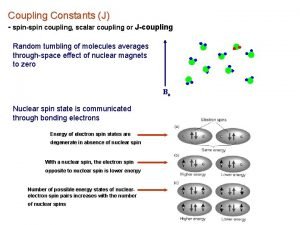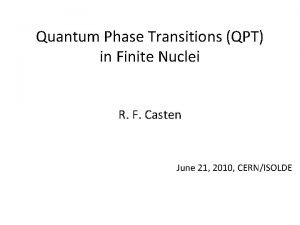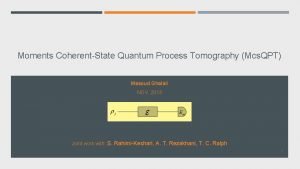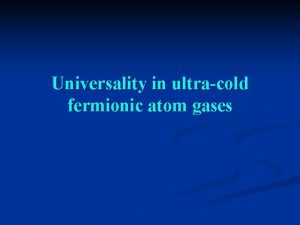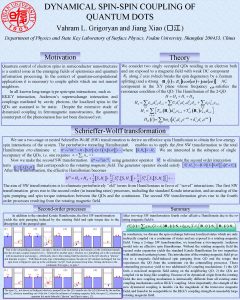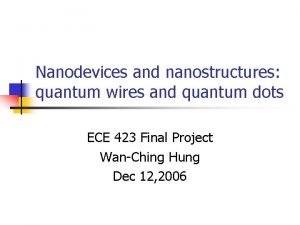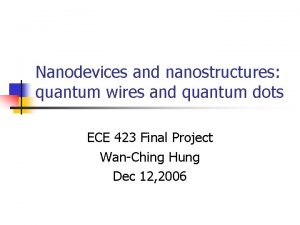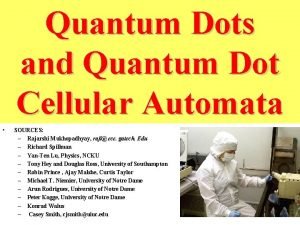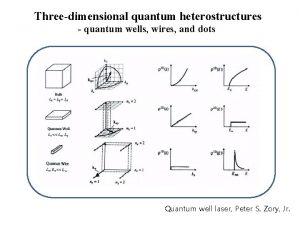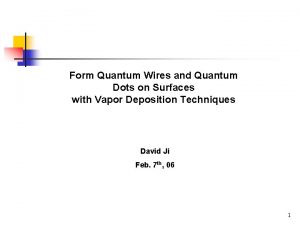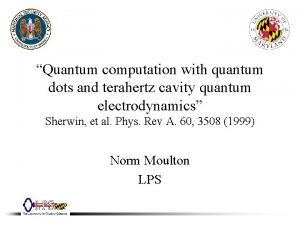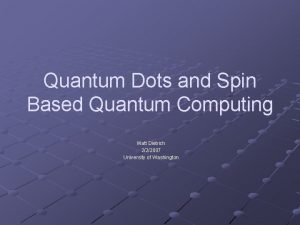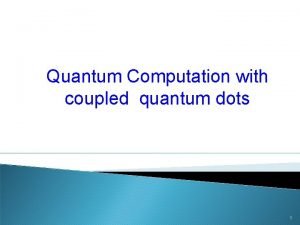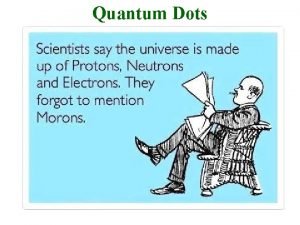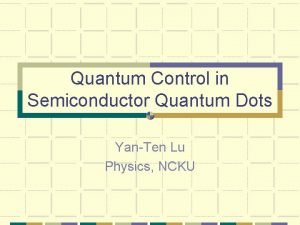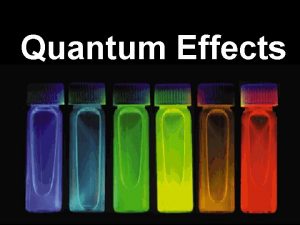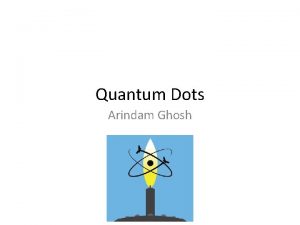Coupling quantum dots to leads Universality and QPT






























![RG analysis • Generically (no symmetries): 15 coupled RG equations [Cardy ’ 81? ] RG analysis • Generically (no symmetries): 15 coupled RG equations [Cardy ’ 81? ]](https://slidetodoc.com/presentation_image_h/d8829dc0fbf13ededa5222d2a2c83e89/image-31.jpg)









- Slides: 40

Coupling quantum dots to leads: Universality and QPT Richard Berkovits Bar-Ilan University Moshe Goldstein (BIU), Yuval Weiss (BIU) and Yuval Gefen (Weizmann)

Quantum dots • “ 0 D” systems: – Artificial atoms – Single electron transistors • Realizations: – Semiconductor heterostructures – Metallic grains – Carbon buckyballs & nanotubes – Single molecules


Level population R L (Spinless) n 1 , n 2 Vg energy 2 e 1 e 2+U 2 2 2 1 1 Vg

Population switching (Spinless) energy 2 R L 1 2 1 2 1 [Weidenmüller et. al. `97, `99, Silvestrov & Imry ’ 00 …] n 1 , n 2 Vg e 2+U Also relevant for: • Charge sensing by QPC [widely used] • Phase lapses [Heiblum group 97’, 05’]

Is the switching abrupt? • Yes ? (1 st order) quantum phase transition • No ? continuous crossover Numerical data (FRG, NRG, DMRG) indicate: No [see also: Meden, von Delft, Oreg et al. ]

Lets simplify the question: Could a single state coupled to a lead exhibit an abrupt population change as function of an applied gate voltage? (i. e. a quantum phase transition)


Furusaki-Matveev prediction Discontinuity in the occupation of a level coupled to a Luttinger liquid with g<½ n 0 1 PRL 88, 226404 (2002) e. F e 0

Model • A single level quantum dot coupled to – a Fermi Liquid (FL) – a Luttinger Liquid (LL) – a Charge Density Wave (CDW) • Spinless electrons

Numerical method: Density Matrix Renormalization Group (DMRG)

Infinite size DMRG

Finite size DMRG Iteration improve dramatically the accuracy

Model and phase diagram for the wire -1 XY 1 AFM D Phase separation -2 LL 2 CDW U/t FM Half filling 1 Filling Non interacting point 0 0. 5 2 0 U/t Haldane (1981)

Evaluating the Luttinger Liquid parameter g g can be evaluated by calculating the addition spectrum and the energy of the first excitation, since By fitting both curves to a polynomial in 1/L and calculating the ratio of the linear coefficients

Results: Furusaki-Matveev jump n 0 L=300 1 L=100 e. F e 0 G ≈ 0. 13; W g=0. 42 Slope is linear in L suggesting a first order transition in thermodynamic limit Y. Weiss, M. Goldstein and R. Berkovits PRB 77, 205128 (2008).

Parameter space for a level coupled to a Luttinger Liquid Coupling Parameters Wire parameters Dot-lead interaction Dot-lead hopping LL parameter Velocity Density at wires edge a. FES Fermi Edge Singularity parameter G 0 Renormalized level width

Yuval-Anderson approach • The system can be mapped onto a classical model of alternating charges (Coulomb gas) on a circle of circumference b (inverse temperature): n 1 0 – + – + b t x 0: short time cutoff; G 0: (renormalized) level width; a. FES: Fermi edge singularity exponent

Coulomb gas parameters Fermi liquid Bosonization General case a. FES G 0 n 0: density of states at the lead edge; g, vs: LL parameters • In general, deff can be found using boundary conformal field theory results [Affleck and Ludwig, J. Phys. A 1994] • In particular, for the Nearest-Neighbor (XXZ) chain, from the Bethe Ansatz:

Conclusions from this mapping: Thermodynamic properties, such as population, dynamic capacitance, entropy and heat capacity: • Are universal, i. e. , depend on the microscopic model only through a. FES, G 0 and e 0 • Are identical to their counterparts in the anisotropic Kondo model M. Goldstein, Y. Weiss, and R. Berkovits, Europhys. Lett. 86, 67012 (2009)

Lessons from the Kondo problem For small enough G 0: • For a. FES<2, low energy physics is governed by a single energy scale (“Kondo” temperature) and; Thus, for small e 0, where: No power law behavior of the population in the dot! Tk is reduced by repulsion in the lead or attractive dot-lead interaction, and viceversa • When a. FES>2, population is discontinuous as a function of e 0 [Furusaki and Matveev, PRL 2002]

Physical insight: Competition of two effects (I) Anderson Orthogonality Catastrophe, which leads to suppression of the tunneling – zero level width (II) Quasi-resonance between the tunneling electron and the hole left behind (Mahan exciton), which leads to an enhancement of the tunneling – finite level width For a Fermi liquid and no dot-lead interaction (II) wins – finite level width Attractive dot-lead interaction or suppression of LDOS in the lead (LL) suppresses (II) and may lead to (I) gaining the upper hand zero level width

Reminder: X-ray edge singularity energy Absorption spectrum: • Without interactions: w 0 • Anderson orthogonality catastrophe (’ 67): e ––– ––– • Mahan exciton effect (’ 67): S(w) 0 w 0 noninteracting Anderson Mahan w

X-ray singularity physics (II) Assume g=1 (Fermi Liquid) e Mahan exciton vs. Scaling dimension: Anderson orthogonality For U>0 (repulsion) <1 relevant > Mahan wins: Switching is continuous

X-ray singularity physics (III) Assume g=1 (Fermi Liquid) e Mahan exciton e vs. Scaling dimension: Anderson orthogonality For U<0 (attraction) >1 irrelevant < Anderson wins: Switching is discontinuous

Population: DMRG (A) Density matrix renormalization group calculations on tight-binding chains: L=100 vs/v. F and G 0=10 -4 tlead [tlead – hopping matrix element]

Population: DMRG (B) Density matrix renormalization group calculations on tight-binding chains: L=100 vs/v. F and G 0=10 -4 tlead [tlead – hopping matrix element]

Differential capacitance vs. a FES

Back to the original question R L Electrostatic interaction [Kim & Lee ’ 07, Kashcheyevs et. al. ’ 07, Silvestrov and Imry ‘ 07] Level widths:

Coulomb gas expansion • One level & lead: – Electron enters/exits Coulomb gas (CG) of positive/negative charges [Anderson & Yuval ’ 69; Wiegmann & Finkelstein ’ 78; Matveev ’ 91; Kamenev & Gefen ’ 97] L • Two levels & leads R Two coupled CGs [Haldane ’ 78; Si & Kotliar ‘ 93]
![RG analysis Generically no symmetries 15 coupled RG equations Cardy 81 RG analysis • Generically (no symmetries): 15 coupled RG equations [Cardy ’ 81? ]](https://slidetodoc.com/presentation_image_h/d8829dc0fbf13ededa5222d2a2c83e89/image-31.jpg)
RG analysis • Generically (no symmetries): 15 coupled RG equations [Cardy ’ 81? ] • Solvable in Coulomb valley: • Three stages of RG flow: 11 (I) (II) 10 01 (III) • Result: an effective Kondo model 00

Arriving at … • Anti-Ferromagetic Kondo model • Gate voltage magnetic field Hz population switching is continuous (scale: TK) No quantum phase transition [Kim & Lee ’ 07, Kashcheyevs et. al. ’ 07, Silvestrov and Imry ‘ 07]

Nevertheless … L R Considering Luttinger liquid (g<1) leads or attractive dot-lead Interactions will change the picture. population switching is discontinuous : a quantum phase transition

Abrupt population switching Soft boundary conditions

Finite size scaling for LL leads W

A different twist R L • Adding a charge-sensor QPC (Quantum Point Contact): – 15 RG eqs. unchanged – Three-component charge population switching is discontinuous : a quantum phase transition

X-ray singularity physics (I) Electrons repelled/attracted to filled/empty dot: e L Mahan exciton vs. Scaling dimension: e R Anderson orthogonality <1 relevant > Mahan wins: Switching is continuous

X-ray singularity physics (II) e L e Mahan exciton R e vs. Anderson orthogonality QPC + Scaling dimension: Extra orthogonality >1 irrelevant < + Anderson wins: Switching is abrupt

A different perspective • Detector constantly measures the level population • Population dynamics suppressed: Quantum Zeno effect ! Sensor may induce a phase transition

Conclusions • Population switching: a steep crossover, No quantum phase transition • Adding a third terminal (or LL leads): 1 st order quantum phase transition • Laboratory: Anderson orthogonality, Mahan exciton & Quantum Zeno effect
 Qpt towing
Qpt towing Leininger sunrise model
Leininger sunrise model History of quantum dots
History of quantum dots Evident technologies
Evident technologies Subjective universality
Subjective universality Hyperacute t waves
Hyperacute t waves Origin of quantum mechanics
Origin of quantum mechanics Quantum physics vs quantum mechanics
Quantum physics vs quantum mechanics 70 degree fahrenheit to celsius
70 degree fahrenheit to celsius Code morse
Code morse Count the dots audiogram
Count the dots audiogram Schuffner dots malaria
Schuffner dots malaria Which artist utilized benday dots in his artwork
Which artist utilized benday dots in his artwork Dots in plastering
Dots in plastering Maurer dots
Maurer dots Fixing into thermalite blocks
Fixing into thermalite blocks Trantas dots
Trantas dots Tbnow
Tbnow Think dots differentiated instruction
Think dots differentiated instruction Think dots differentiated instruction
Think dots differentiated instruction Ocl lewis structure
Ocl lewis structure Darko hunter
Darko hunter Dippin' dots precio
Dippin' dots precio Exploding dots subtraction
Exploding dots subtraction Connect the dots lewis dot symbols lesson 31
Connect the dots lewis dot symbols lesson 31 Connect 1 2 3 without crossing lines
Connect 1 2 3 without crossing lines Clear the blue dots
Clear the blue dots What is the maximum number of pieces
What is the maximum number of pieces Simply dots
Simply dots Ben-day dots
Ben-day dots Gold standard malaria
Gold standard malaria Think dots
Think dots Roy lichtenstein (1923-1997)
Roy lichtenstein (1923-1997) Dots expansion
Dots expansion Ikatan pertolongan cemas
Ikatan pertolongan cemas What do the dots represent
What do the dots represent How many
How many Dots tb
Dots tb Dots tbc
Dots tbc Shilentnobyte
Shilentnobyte Pop art adobe illustrator
Pop art adobe illustrator
